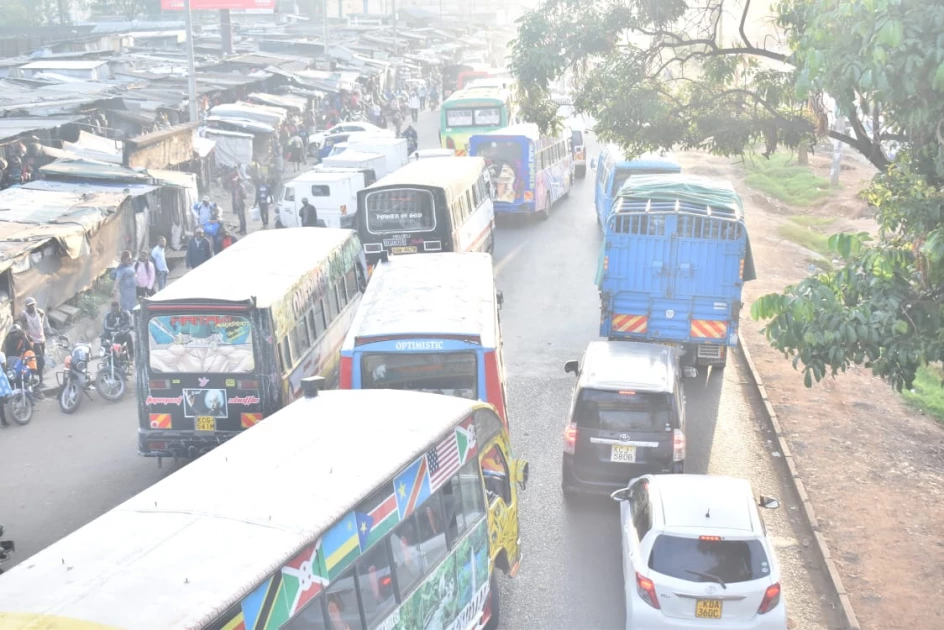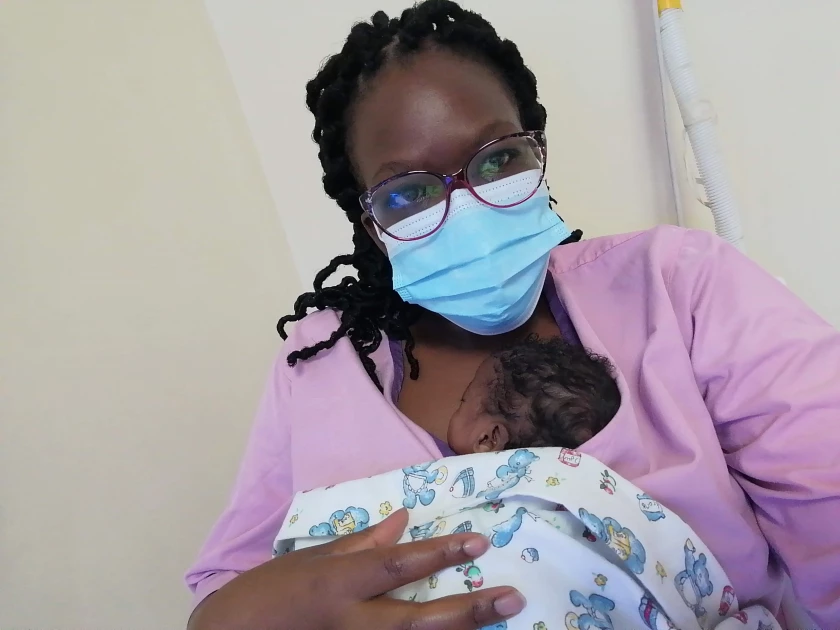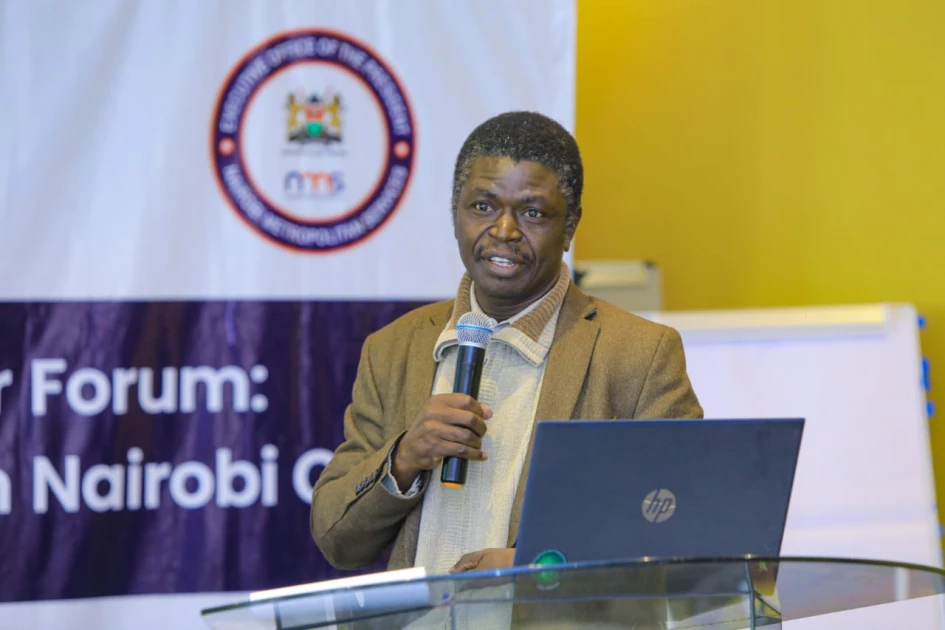How air pollution in Nairobi is fueling preterm births – risks and dangers

A glimpse of the chaotic traffic that is a common denominator in Nairobi streets. They matatus emit fumes which is hazardous to the environment. PHOTO/Zachary Mayieka/Citizen Digital.
It’s early Friday morning in Nairobi’s Industrial Area. Dark
clouds of smoke furiously billow from the chimneys of the many industries
dotting this area, and in unison, perhaps guided by a common goal, dash for the Nairobi
skies.
The thick, dark clouds make the shiny sky cloudy,
illustrating the city’s bustling manufacturing sector and its negative
environmental impact.
Between three of the industries, resides Virginia Waithera, a
business lady and mother of two, who runs business at Athi River town.
Waithera’s first two children were preterm babies. The
first born came in 2006, and the second born in 2013.
The 37-year-old mother says her first pregnancy was normal,
till the 30th week when she developed complications.
“In the 30th week, I noticed swelling of my legs, puffy face
and after checking my pressure, it was too high, 199/100,” she says. “I went to
hospital and doctors said I had a condition called preeclampsia.”
Living around Industrial Area, where most of industries in
Nairobi are based, Waithera says she suffered from effects of industrial
pollution during her first pregnancy.
“You see I am surrounded by three industries and I usually
had problems at night during my pregnancies,” said Waithera. “When I was
pregnant for my first born, I could feel nauseated, headache and the smell from
fumes was really unbearable.”
She adds, “Even Athi River which is just a few metres from
our area, there is a lot of dumping of dirt and raw sewage lines are directed
to the river.”
Preterm babies surge
in Nairobi
Nairobi City County tops in the list of top 10 counties with
high rates of preterm births in Kenya. Data from the Ministry of Health shows
that Nairobi leads with 5,338 babies born too soon. According to the data, the
rate of premature births is at 12%.
Preterm birth refers to when a baby is born before
completion of the 37 weeks of pregnancy.
The World Health Organisation (WHO) says preterm birth
complications lead in causing death among children under the age of five, and contributed
to an approximately one million deaths in the year 2015, globally.
However, experts warn that levels of air pollution in
Kenya’s capital city could be one of the reasons the city is leading in preterm
babies.
According to Waithera, the river stinks at night and they
find it difficult to enjoy their sleep, and they have been forced to get used
to it because of the hard economic times.
Waithera narrated how her son suffered a lot when he was
young with unending flu and chest problems which he was forced to live with.
“I think we are now immune in this area as opposed to those
who are moving into this area,” she said jokingly.
After being diagnosed with preeclampsia, Waithera did not
bother to talk about the effects of industrial fumes. Preeclampsia is a
pregnancy-related condition characterized by hypertension.
Dr. Bridget Nyanchama of Coptic Hospital says exposure to
various air pollutants such as nitrogen oxide and sulfur dioxide and ozone may
make it possible for a preterm baby.
“You see as one inhales polluted air into the body system,
there is a possibility of placental inflammation which may lead to premature
labor resulting to a preterm baby,” says Dr. Nyanchama.
The fumes from industries may contain toxic materials such
as metals and some organic materials. She warns that the fumes can cause
several health issues especially respiratory complications.
“Expectant women are most vulnerable due to high demand of
oxygen and there are several body changes during pregnancy including respiratory
changes,” Dr. Nyanchama explains.
Reduced oxygen and nutrient supply to the foetus, according
to her, leads to reduced fetal growth and hence low birth weight. These conditions
may lead to complications such as preeclampsia.
Like Virginia Waithera, Symphrose Okinda, a journalist and a
mother of two, shares a similar story on her pregnancy journey.
Symphrose’s pregnancy had zero complications until the 32nd week when she noticed that her urine had some traces.
“At first I was not bothered because I was at work. I
ignored and continued working hoping it would go away,” she said. “A few
minutes later I went back to the washroom and this time I saw my mucus plug.”
At this point she knew that something was not right and her
unborn baby was in danger and something must be done to save the baby. She was
rushed to the hospital.
Symphrose normally uses her car to work because she is not comfortable with the fumes especially from public transport vehicles.

Dr. Nyanchama advises that those pregnant women who spend
significant time in traffic or live near busy roads are exposed to high level
of pollutants.
These pollutants, she says, will affect the placenta leading
to reduced flow of blood and oxygen to the fetus which triggers preterm labour.
Prof. Paul Njogu, a research and data lecturer at Jomo
Kenyatta University of Agriculture and Technology (JKUAT) says that air
pollutants are released by both natural and human sources and that human
sources constitute the biggest source which include; vehicles, industries,
solid wastes burning and residential fires among others.
“Combustion or burning of fuels in industries, homes and
vehicles constitute the single most cause,” he said. “Other gases such as
carbon dioxide are not considered pollutants but are responsible of global
warming as a result of trapping heat in the lower atmosphere.”
Prof. Njogu warns that the rate of air quality in Nairobi is
deteriorating beyond acceptable levels set by the World Health Organization.
“This is as a result of increase in population which has
seen a commensurate increase in consumption of goods and need for transport
thus more burning of fuels for instance,” he added.
The open solid waste burning has also exacerbated the air
pollution problem as well as use of old vehicles whose air pollution control
devices have been removed or are not functioning properly.
Expectant mothers represent a vulnerable group among the
population due to their compromised health condition.
“Expectant mothers are more likely to show ill symptoms even
at low pollution exposure levels,” Prof. Njogu says. “These classes or members
of the population should be protected or should take measures such as use of
nose masks as well as other protective gear or avoid polluted areas during
pregnancy if possible.”
Professor Augustine Afullo, an environmental health expert
working with GeoHealth East African Hub argues that air pollution causes several
complications including preterm births.
From his research, most the most affected area is the east
part of Nairobi where most rubbish is burnt and every other industry is placed.
When pregnant mothers are exposed to air pollution, their
lung capacity is compromised and may affect the unborn baby.
“When a pregnant mother is exposed to pollution, she is
unable to breathe well and she may develop asthma or chronic obstructive
pulmonary disease,” said Prof. Afullo. “Lung function is reduced and that may
make the ability of the mother to supply enough oxygen to the unborn child to
be compromised.”
He warns that if the exposure is repeated a number of times,
then the body treats the unborn child as a foreign object and the body feels to
throw it out.
For the safety of the foetus, the baby needs highest
concentration of good quality food and oxygen but when exposed to pollution,
the placenta may transmit the pollutants to the foetus that may lead to pre-term
birth or worst, death of the foetus.
“If the body’s ability to supply food and oxygen to the
young is compromised, wastes may accumulate and cause loose mother-child body
contact causing preterm birth or abortion,” he warned. “Anything that happens
in the body will easily compromise the foetus.”
Why the foetus is
endangered
Prof. Njogu argues that studies have shown that some
pollutants can enter the blood system and cross the umbilical cord thus
exposing the foetus which in extreme cases can lead to miscarriage.
He warns that the smells from burning of tires, fuels and
compounds of sulphur and nitrogen dioxide give pungent smells that can even
shock some vulnerable members of the population.
He however insisted that air pollution problem is not
localized, once released to the air the pollutants travel long distances and
can be found in areas where they are not generated.
He says that there is no place in Nairobi that is safe from
pollution even if some areas might have higher levels of pollutants due to
continued release or poor removal by wind.
“Areas around industries, near roads with heavy traffic,
next to areas with frequent incidences of open solid wastes burning, hospital
incinerators and areas in valleys generally will have high levels of
pollutants,” he warned.
The eastern part of Nairobi city is blamed to have high
pollution levels relative to the other areas. The areas bordering cement
industries in Athi River and Syokimau areas are shown as pollution hotspots in
satellite images.
On tackling air pollution, Professor Njogu has advised
several approaches to reduce its effects.
“Simple actions like
stoppage of open solid waste burning and using pooled transport will reduce
emissions from private vehicles which constitute the largest population on our
roads,” he advises.
He advocates for the use of clean energy sources such as
solar and wind energy which are in abundance in Kenya and follow the footsteps
of Sweden in walking and cycling which doesn’t result to fuel burning.
“Using public awareness where the community is educated on
the impacts of the things we do can lead to behavioral change,” he suggested.
In the extremes he proposes good maintenance of combustion
devices including cars and industrial furnaces and boilers and installation of
air pollution reduction devices in cars among others.
“In order to reduce pollution from industries and car fumes,
there is need to implement advanced pollution control technologies like
scrubbers, filters and electrostatic precipitators,” Prof. Njogu said.
Prof. Afullo blames the government failure to embrace and award research efforts in the country which has led to many scientists and researchers to shun research for better paying jobs.

“Most hospitals have potential researchers on this issue but
they are few and overwhelmed. They have no time for research,” he regretted.
“A few medical specialists are field researchers because
majority of them are ward based. Once they become specialists, that is the end
of it,” he said.
He cited lack of incentives for research and it does not
happen in Kenya alone but in many developing countries.
This story was produced as part of Internews Earth Journalism Network’ 2024 Reporting fellowship [ The author, Zachary Mayieka is a News Reader at Egesa FM, one of the 13 radio stations under the RMS stable. He is passionate about environmental reporting.
Want to send us a story? SMS to 25170 or WhatsApp 0743570000 or Submit on Citizen Digital or email wananchi@royalmedia.co.ke
Comments
No comments yet.


Leave a Comment